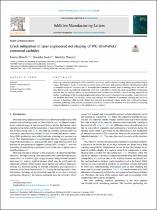 ResearchSpace
ResearchSpace
Crack mitigation in laser engineered net shaping of WC-10wt%FeCr cemented carbides
JavaScript is disabled for your browser. Some features of this site may not work without it.
- ResearchSpace
- →
- Research Publications/Outputs
- →
- Journal Articles
- →
- View Item
| dc.contributor.author |
Molobi, E

|
|
| dc.contributor.author |
Sacks, N

|
|
| dc.contributor.author |
Theron, Maritha

|
|
| dc.date.accessioned | 2022-03-13T16:43:59Z | |
| dc.date.available | 2022-03-13T16:43:59Z | |
| dc.date.issued | 2022-04 | |
| dc.identifier.citation | Molobi, E., Sacks, N. & Theron, M. 2022. Crack mitigation in laser engineered net shaping of WC-10wt%FeCr cemented carbides. <i>Additive Manufacturing Letters, 2.</i> http://hdl.handle.net/10204/12314 | en_ZA |
| dc.identifier.issn | 2772-3690 | |
| dc.identifier.uri | https://doi.org/10.1016/j.addlet.2022.100028 | |
| dc.identifier.uri | http://hdl.handle.net/10204/12314 | |
| dc.description.abstract | Laser engineered net shaping of a WC-10wt%FeCr cemented carbide showed cracking during deposition despite using a full factorial design of experiments matrix along with single and multiple objective optimization models to establish an optimal parameter set. In this study four techniques namely, laser re-melting, use of FeCr and Ni-alloy butter layers, and substrate preheating, were used in an effort to reduce the crack susceptibility of deposited samples and the resultant effects on microstructure and hardness were studied. Laser re-melting improved the surface morphology of the deposited samples and reduced the number of primary and secondary cracks, however the hardness decreased. The Ni-alloy butter layer reduced the formation of secondary cracking and led to an increase in hardness, while the FeCr butter layer resulted in increased primary cracks and a reduced hardness. Substrate preheating reduced crack formation and led to an increase in the hardness with the reduction in cracking being attributed to a reduction of the initial thermal gradient. | en_US |
| dc.format | Fulltext | en_US |
| dc.language.iso | en | en_US |
| dc.relation.uri | https://www.sciencedirect.com/science/article/pii/S2772369022000032 | en_US |
| dc.source | Additive Manufacturing Letters, 2 | en_US |
| dc.subject | Directed energy deposition | en_US |
| dc.subject | Crack mitigation | en_US |
| dc.subject | Cemented tungsten carbides | en_US |
| dc.subject | Thermal gradient | en_US |
| dc.title | Crack mitigation in laser engineered net shaping of WC-10wt%FeCr cemented carbides | en_US |
| dc.type | Article | en_US |
| dc.description.pages | 8 | en_US |
| dc.description.note | © 2022 The Authors. Published by Elsevier B.V. This is an open access article under the CC BY-NC-ND license (http://creativecommons.org/licenses/by-nc-nd/4.0/) | en_US |
| dc.description.cluster | Manufacturing | en_US |
| dc.description.impactarea | Laser Enabled Manufacturing | en_US |
| dc.identifier.apacitation | Molobi, E., Sacks, N., & Theron, M. (2022). Crack mitigation in laser engineered net shaping of WC-10wt%FeCr cemented carbides. <i>Additive Manufacturing Letters, 2</i>, http://hdl.handle.net/10204/12314 | en_ZA |
| dc.identifier.chicagocitation | Molobi, E, N Sacks, and Maritha Theron "Crack mitigation in laser engineered net shaping of WC-10wt%FeCr cemented carbides." <i>Additive Manufacturing Letters, 2</i> (2022) http://hdl.handle.net/10204/12314 | en_ZA |
| dc.identifier.vancouvercitation | Molobi E, Sacks N, Theron M. Crack mitigation in laser engineered net shaping of WC-10wt%FeCr cemented carbides. Additive Manufacturing Letters, 2. 2022; http://hdl.handle.net/10204/12314. | en_ZA |
| dc.identifier.ris | TY - Article AU - Molobi, E AU - Sacks, N AU - Theron, Maritha AB - Laser engineered net shaping of a WC-10wt%FeCr cemented carbide showed cracking during deposition despite using a full factorial design of experiments matrix along with single and multiple objective optimization models to establish an optimal parameter set. In this study four techniques namely, laser re-melting, use of FeCr and Ni-alloy butter layers, and substrate preheating, were used in an effort to reduce the crack susceptibility of deposited samples and the resultant effects on microstructure and hardness were studied. Laser re-melting improved the surface morphology of the deposited samples and reduced the number of primary and secondary cracks, however the hardness decreased. The Ni-alloy butter layer reduced the formation of secondary cracking and led to an increase in hardness, while the FeCr butter layer resulted in increased primary cracks and a reduced hardness. Substrate preheating reduced crack formation and led to an increase in the hardness with the reduction in cracking being attributed to a reduction of the initial thermal gradient. DA - 2022-04 DB - ResearchSpace DP - CSIR J1 - Additive Manufacturing Letters, 2 KW - Directed energy deposition KW - Crack mitigation KW - Cemented tungsten carbides KW - Thermal gradient LK - https://researchspace.csir.co.za PY - 2022 SM - 2772-3690 T1 - Crack mitigation in laser engineered net shaping of WC-10wt%FeCr cemented carbides TI - Crack mitigation in laser engineered net shaping of WC-10wt%FeCr cemented carbides UR - http://hdl.handle.net/10204/12314 ER - | en_ZA |
| dc.identifier.worklist | 25506 | en_US |





